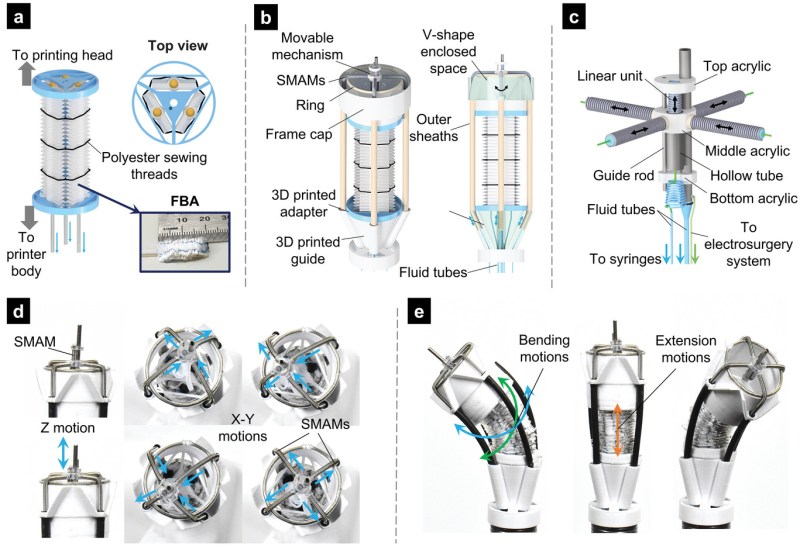The progress of medical science has meant increasingly more sophisticated ways to inspect and repair the body, with a shift towards ever less invasive and more effective technologies. An exciting new field is that of in situ tissue replacement in a patient, which can be singular cells or even 3D printed tissues. This in vitro approach of culturing replacement tissues comes however with its share of issues, such as the need for a bioreactor. A more straightforward approach is printing the cells in vivo, meaning directly inside the patient’s body, as demonstrated by a team at the University of New South Wales Sydney with a soft robot that can print layers of living cells inside for example a GI tract.
In their paper, the team — led by [Dr Thanh Nho Do] and PhD student [Mai Thanh Thai] — describe the soft robot that is akin to a standard endoscope, but with a special head that has four soft microtubule artificial muscles (SMAM) for three degrees of freedom and fabric bellow actuators (FBA) that provide the motion desired by the remote controller. The system is configured in such a way that the operator inputs the rough intended motions, which are then smoothed by the software before the hydraulics actuate the head.
In a test on a simulated GI tract, the researchers were able to manipulate a prototype, and deposit a range of materials from the installed syringes. They envision that a system like this could be used as with endoscopes and laparoscopy to not only accurately deposit replacement cells inside the patient’s body, but also to perform a range of other surgical interventions, whereby the surgeon is supported by the system’s software, rather than manipulating the instruments directly.

















Couldn’t get a feel for the size but finally found that the smallest prototype is approximately 11.5mm in diameter which is within the size range of an endoscope (11-13mm). The proof-of-concept surgery was done on a pig intestine. I have no idea of what they constructed it but since it’s a medical device, it will need to withstand prolonged sterilization temperatures (30min @ 500F/260C) which is why medical devices are mostly made of metals but that likely wasn’t a concern for prototyping.
Not necessarily; plenty of devices (especially low-cost, disposable devices) are sterilized with low-temperature methods such as ethylene oxide, gamma radiation, or e-beam.
Correct. Like half the endoscopic surgical stuff is plastic anyway (staplers, catch bags and so on) and tons of other medical stuff is plastic like single use scalpels etc.
Also, endoscopes (the butt variety) and flexible ENT scopes are all flexy and aren’t exactly sterilized, they are “high level sanitized” which, to paraphrase, it’s sterile. Maybe not 100% sterile. Haha
There are other methods of sterilisation, and for a device that seems (to me at least) like it should be very very useful it probably doesn’t matter that much what it costs to sterilise it via whatever methods it will survive, or to make the bits that can’t take it single use. Not like the medical industry is ever going to get entirely away from single use either.
I mean, not bad, but let’s give Michael Reeves a chance to re-engineer this first.
As far as practicality goes, I don’t know where something like this could work. Shortening the duration of surgeries is always a goal to increase likelihood of success (and survivability). The idea of 3D printing in situ seems completely antithetical to that. Cool accomplishment, though.
That’s too simplistic thinking, not all surgeries need to be done during anesthesia. This could work well for open wounds or big flesh wounds. They are not an immediate threat to life, but they heal slowly or scar. Instead of scaring, printing cells onto the wound could make it heal faster and with much higher quality tissue.
As a surgeon of 20+ years, these days I perform far more laparoscopic surgery rather than laparotomy, I find this fascinating. Though not likely to be practical in my lifetime.